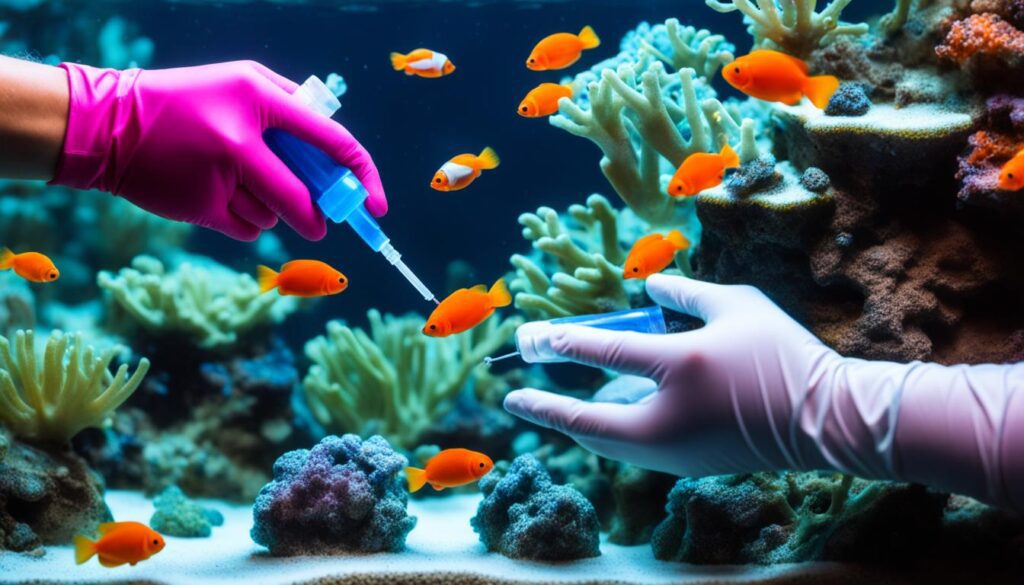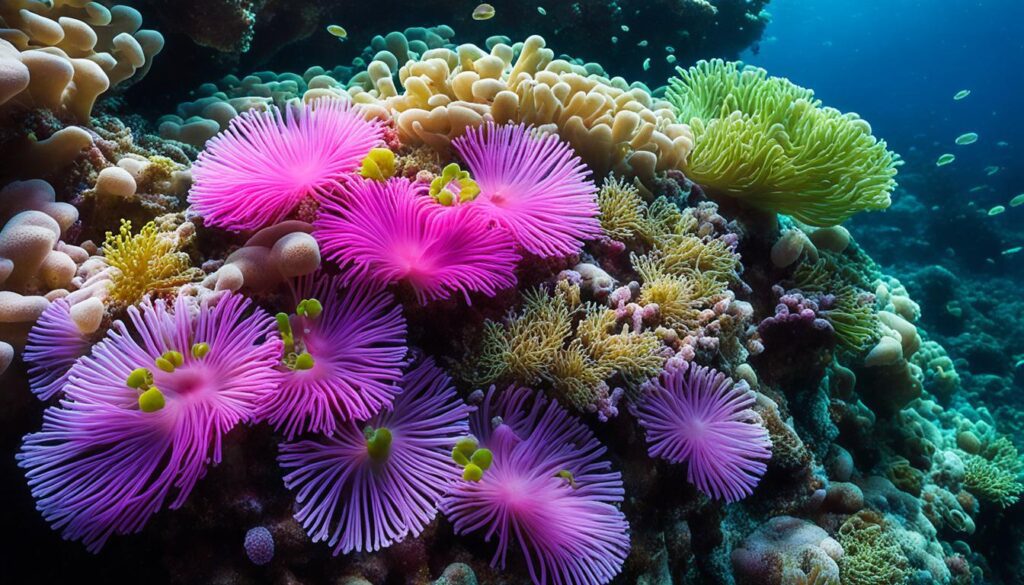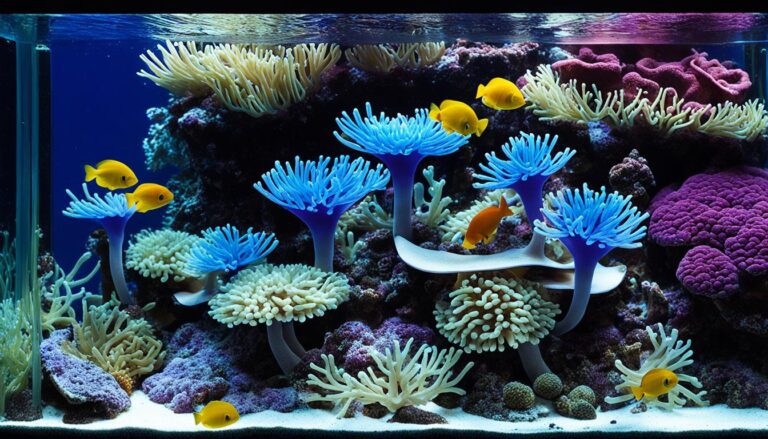Have you ever seen a single unwanted guest take over a whole party? Imagine this in your saltwater aquarium: Aiptasia anemones can quickly become a huge problem. They can spread fast, taking over every corner of your tank. But, there’s hope – over 90% of Aiptasia can be removed with the right treatment, like Aiptasia X solution.
As a marine hobbyist, I learned how crucial it is to spot and eliminate Aiptasia early. These pests can harm other marine life with their venom. They reproduce quickly, both sexually and asexually, making them a big threat. That’s why controlling them is key to protecting your tank’s life.
I’ve found that the Berghia nudibranch is a hero against Aiptasia in big tanks. But, these nudibranchs might not find food if there aren’t enough Aiptasia. Also, not all peppermint shrimp can control Aiptasia. Only Lysmata Wurdemanni shrimp are good at it.
If you’re concerned about maintaining the harmony of your aquarium, it’s crucial to tackle aiptasia pests with care. Treatments like F-Aiptasia are effective at eliminating these pesky intruders without throwing your tank out of whack. Whether you have just a few or a full-blown infestation, managing aiptasia is key to keeping your tank’s ecosystem healthy and balanced.
Aiptasia Anemone Menace

Aiptasia anemones are a big problem for aquariums. They can quickly take over, upsetting the balance and harming marine life. It’s important to know how to deal with them to keep our aquariums healthy.
Characteristics of Aiptasia Anemones
Aiptasia anemones look like trees and can grow up to 2 inches tall. They blend in well, making them hard to spot. They live in bright places and change color to match their surroundings.
In low light, they look almost invisible. This shows how adaptable and tough they are.
The Rapid Reproduction of Aiptasia
Aiptasia anemones can grow fast, leading to big problems quickly. This makes controlling them hard. It’s important to act fast to stop them from taking over.
Aiptasia’s Defense Mechanisms and Impact on Aquarium Life
Aiptasia anemones have stinging cells that can hurt other sea creatures and coral. They are a real threat to aquarium life. We need good ways to control them to keep the aquarium balanced.
Keeping an aquarium healthy means watching for problems like Aiptasia. Knowing how they grow and defend themselves helps us keep our marine world balanced.
How to Identify Aiptasia in Your Saltwater Aquarium

Knowing how to spot aiptasia is key. These anemones, often seen as pests, can harm your aquarium if not controlled. They look like small palm trees with up to 100 sharp tentacles and a strong base that sticks to rocks.
To tell them apart from other anemones, watch how they react when touched. Aiptasia quickly pull back, making them hard to get rid of. For more help on identifying them, check out this guide.
It’s vital to know how they grow and multiply to control them. Aiptasia can start small but grow big, showing they can breed. They spread fast, covering your aquarium if not stopped quickly.
Here are some key facts about these pests:
- Only 25% of anemones seen in tanks are actually Aiptasia.
- About 70% of what seem to be Aiptasia are not confirmed, showing how tricky it is to identify them.
To fight these pests, using natural predators like Peppermint Shrimp and Lemonpeel Pygmy Angelfish works well. You can also use Aiptasia-X, a chemical solution that won’t harm other fish.
Pest Control Method |
Effectiveness |
|---|---|
Peppermint Shrimp |
High |
Lemonpeel Pygmy Angelfish |
Moderate to High |
Aiptasia-X |
High |
Keep an eye on your tank and do regular water changes to stop Aiptasia. 48.3% of aquarium owners change their water weekly, which helps keep Aiptasia away.
Common Aiptasia Anemone Habitats and Behaviors

Exploring the aiptasia habitat and behavior shows why they are a problem in both nature and tanks. Aiptasia anemones, like Aiptasia diaphana, live in many conditions. They are tough and can adapt easily.
Natural Habitats vs. Aquarium Environments
In the wild, Aiptasia anemones live in shallow waters and up to 10M deep. They stick to hard surfaces like rocks or mangrove roots in poor water areas. This lets them easily move into aquariums, often on live rock.
In aquariums, where food is always there and conditions are stable, they can grow in large numbers. To stop them from taking over, aquarium pest control is key. This can be done with natural predators like peppermint shrimp or by using chemicals to keep the tank balanced.
Feeding Patterns of the Aiptasia Anemone
Aiptasia anemones eat whatever they can. They get food from sunlight with the help of zooxanthellae algae and catch prey with their tentacles. These tentacles have stinging cells that paralyze small animals and fish. This way of eating helps them survive but can be a problem in tanks.
Understanding aiptasia behavior and their aiptasia habitat helps in controlling them. To keep the aquarium healthy, it’s important to manage these anemones with aquarium pest control methods.
Aiptasia
As an aquarist, I’ve faced many challenges, but Aiptasia anemones are a big one. These anemones, like Aiptasia pallida and Aiptasia pulchella, reproduce fast and outcompete other sea creatures. This can cause problems in both small and large aquariums.
Dealing with aiptasia solution means understanding their biology and life cycle. They can reproduce both sexually and asexually, making them hard to control. They can even regrow an entire anemone from a small piece, making it tough to get rid of them.
Aiptasia can be found all over the world, in warm and tropical oceans. They spread through human activities like shipping and coral farming. Even with efforts to control them, they still show up in places like Tonga and Indonesia.
- Aiptasia can stress corals and other sea creatures, lowering the variety of life in the tank.
- Using natural predators like peppermint shrimp and nudibranchs like Aeolidiella stephanieae is a common way to fight aiptasia.
Stopping Aiptasia is key to keeping aquariums looking good and healthy. In my experience, it takes careful watching, prevention, and using the right methods to control them. Every effort to get rid of aiptasia helps make the aquarium ecosystem better.
Comparing Aiptasia to Other Aquarium Pest Anemones
Dealing with Aiptasia and Majano Anemones in aquariums is key. They are often mixed up, but each needs its own way to be managed.
Distinguishing Between Aiptasia and Majano Anemones
Aiptasia anemones are thin and can quickly take over an aquarium. They are also known as “Glass” or “Rock Anemones”. On the other hand, Majano Anemone is less common and has rounder tentacles. Knowing these differences helps in getting rid of Aiptasia effectively.
Identifying Imposters: Not All “Peppermint Shrimp” Will Eat Aiptasia
Some say to use peppermint shrimp, like Lysmata wurdemanni, to control Aiptasia. But not all “peppermint shrimp” will eat these pests. It’s important to get the right kind for it to work.
To sum up, getting rid of Aiptasia and managing Majano Anemones means knowing what you’re dealing with and using the right methods. The wrong approach can make things worse. So, be careful and use targeted methods to keep your aquarium healthy and beautiful.
Preventative Measures Against Aiptasia Infestation
For those who love saltwater aquarium maintenance, stopping aiptasia is key. These anemones can quickly spread and harm other sea creatures. What steps can I take to keep them out of my tank?
First, it’s important to quarantine new corals, live rocks, or macroalgae. Keeping them separate for at least two weeks helps spot and deal with pests. This is a crucial step in marine pest management.
To protect my aquarium, I check and dip all new items in solutions that kill pests. Regular water changes and keeping an eye on the water’s chemistry also help. These actions keep aiptasia away and keep my tank healthy.
Strategy |
Benefits |
Considerations |
|---|---|---|
Quarantine |
– Isolates new additions – Allows for observation |
– Requires separate setup – Duration of at least 2 weeks |
Dipping |
– Kills hitchhiking pests – Can be done with various solutions |
– Need for correct dosing – Some corals sensitive to dips |
Maintaining Water Quality |
– Stable environment – Discourages pest growth |
– Regular testing required – Consistent maintenance needed |
Knowing about aiptasia helps in catching and managing them early. They can spread quickly, so we must be alert. More on helping marine ecosystems shows the importance of acting early. By following these saltwater aquarium maintenance tips, we can keep our tanks beautiful and healthy.
Adding natural predators to your tank is also a good idea. Peppermint shrimp and sea slugs from the Berghia genus not only add to the tank’s life but also control aiptasia. Using prevention and smart biological solutions keeps your tank lively and free of pests.
Physical vs. Chemical Aiptasia Removal Methods
Dealing with aiptasia treatment in your saltwater aquarium is crucial. It’s important to pick the best method to keep these pests away. We’ll explore both physical and chemical ways to tackle Aiptasia anemones. These methods help keep your marine setup beautiful and safe for fish.
Aiptasia X and Vinegar Treatments: Pros and Cons
Aiptasia X is a top choice for aiptasia solution. It’s easy to use and targets the pests without harming nearby coral and fish. But, be careful not to use it wrong, as it could hurt other sea creatures. Vinegar is another option, a DIY way to kill Aiptasia by shrinking it. But, you must be precise to avoid making the water too acidic.
Natural Predators: Peppermint Shrimp, Filefish, and Berghia Nudibranchs
Natural predators like Peppermint Shrimp, Filefish, and Berghia Nudibranchs can help control aiptasia for good. These creatures eat Aiptasia without disrupting the aquarium’s balance. The Berghia Nudibranch is great because it only eats Aiptasia, but it might starve if there are no more anemones.
Method |
Effectiveness |
Impact on Tank |
Long-Term Solution |
|---|---|---|---|
Aiptasia X |
High |
Low (if applied correctly) |
Moderate |
Vinegar Injection |
Medium |
Medium (risk of pH change) |
Low |
Peppermint Shrimp |
Variable |
Low |
High |
Filefish |
High |
Medium (check compatibility) |
High |
Berghia Nudibranch |
High |
None |
Yes (but risks starvation post-Aiptasia) |
Choosing the right method for aiptasia treatment is key. It’s important to watch and adjust based on your tank’s needs. Sometimes, using both physical and chemical methods, along with natural predators, works best to control these pests.
Innovative Strategies for Aiptasia Control
I’ve been fighting a battle against aiptasia in my saltwater aquarium for about 9 months. Keeping aiptasia under control is key to the health and beauty of our underwater friends. Using new ways to control anemones can really change the game.
Manual methods like Kalk paste, F-aiptasia, lemon juice, and hydrochloric acid work fast. But, biological methods offer lasting solutions. Adding a “hunting pack” of at least 10 medium-sized Berghia Nudibranches has been a game-changer for me. These predators work together to eat the aiptasia, making my tank healthier.
It takes patience, about 4 to 6 months, for the Berghia Nudibranches to control the aiptasia. It’s important to use the right amount of chemicals to keep the tank balanced. Using Red Sea Aiptasia-X and adding certain fish and shrimp helps keep aiptasia away. The right number of these creatures is key to effective pest control.
Preventing aiptasia is just as important as fighting it. Checking new rocks and coral carefully and adjusting feeding habits helps. The key is to watch closely and use a mix of old and new methods. Over three years, I’ve seen a big drop in aiptasia in my tank, showing that with effort, we can beat these pests.








